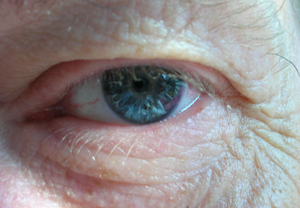The sight prevention program 2005.
At the beginning of the last century, life expectations were a little less than 50 years while today they have surpassed the threshold of 75. In one century, there has therefore been a growth of average life equivalent to a quarter of a century and data confirms that this average is still increasing. Recent studies indicate that the number of people aged 65 years and older
 will
double between 1995 and 2030. Given this phenomenon, the Emilia Romagna
Region (22.2% of its population is over 65 years of age) is one of the most
involved areas in Italy.
will
double between 1995 and 2030. Given this phenomenon, the Emilia Romagna
Region (22.2% of its population is over 65 years of age) is one of the most
involved areas in Italy.This trend will have a strong influence on the epidemiological distribution of eye pathologies with consequencial impact on health infrastructures which will have to respond to the needs of this population.
Even if the most frequent problem of older adults is hearing impairment, the loss of vision is greater as the years go by and represents one of the main causes of disability.
Among the causes of blindness in industrialized countries today, infectious diseases have diminished, but the so-called degenerative forms of blindness have significantly increased because of aging and accidents.
Macular degeneration due to age, glaucoma, the loss of transparency of dioptric means can cause severe consequences on the activities of every day life because of the loss of ability to read, write or move about independently.
Early intervention in these functional and structural changes, prescription of adequate optical aids, and adequate rehabilitative therapy are the basic steps which will reduce possible damages due to a lack of prevention, and will preserve and optimize residual vision, a determinant element to maintain an acceptable level in quality of life.
However, the frequent conditions of poverty, solitude, abandonment, depression and psychophysiological decline, often present in ageing, can influence heavily the possibility of early diagnosis, of adequate therapy and making sure that all precautions are taken to preserve sight.
In this context, Grey Eyes, the sight prevention program of 2005, was introduced.
 It is
coordinated by the Institute for the Blind F. Cavazza, in collaboration with
ANCESCAO, within the framework of activities relating to Project C.I.F.R.A. and
funded by the Fondazione Cassa di Risparmio in Bologna.
It is
coordinated by the Institute for the Blind F. Cavazza, in collaboration with
ANCESCAO, within the framework of activities relating to Project C.I.F.R.A. and
funded by the Fondazione Cassa di Risparmio in Bologna. The protocol includes free examination for those registered with centres for older adults in Bologna that are members of ANCESCAO. The contribution of the medical staff from the department of surgery, resuscitation and transplant A. Valsava of the University of Bologna and of the opticians members of the opticians' union Ascom of Bologna was fundamental. Moreover, thanks to the precious contribution of two important optical clinics in the area, Hoya Lens Spa and Essilor Italia Spa, it was possible to provide people, when necessary, the replacement of glasses at a fixed "social" price. The Istituto per Ottici Benigno Zaccagnini took care of the training of opticians who were part of the campaign. The organizational and coordination assistance was offered by Mr. Andrea Afragoli and Mrs. Raffaela Casini respectively President and Vice President of the Opticians of Bologna.
819 persons were examined, the average age was 70 years, and in 491 cases it was necessary to undergo full examination by an eye specialist. In these cases a visual defect was examined that the person was not even aware of, or for which a complete examination had been necessary for some time. The data relating to the frequency of visits to an eye specialist was in fact surprisingly negative: within the sample of people that underwent examination, only 40% stated that they have annual eye exams while 14% of the group declared to have had a visit to the eye specialist up to 10 years before.
Also interesting is the data concerning glasses: from controls done on lens and frames owned by older adults, in 21% of the cases they were inadequate glasses in terms of refracting value and integrity of the structure with consequencial negative effects on the quality of sight.
On one hand, results show the absolute necessity to constantly promote initiatives of information and prevention for the population, and on the other hand, to ensure the correctness of the initiative, whether it is in terms of its goals or the tools used, most of all for the added-value in terms of quality of life for older adults for whom concepts of health and well-being coincide more and more.